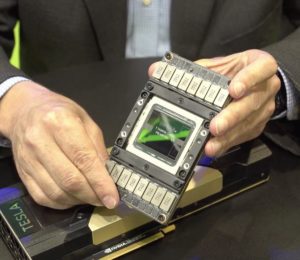In this special guest feature, Brad McCredie from IBM writes that launch of Volta GPUs from NVIDIA heralds a new era of AI.

Brad McCredie is is an IBM Fellow, Vice President of IBM Power Systems Development, and President of the OpenPOWER Foundation.
This is an era of data-centric computing. There’s no doubt about that. For those in hardware engineering who embraced disruption over the past few years – my colleagues at IBM Cognitive Systems and our partner NVIDIA included – this sudden rise of AI-inspired applications is a once or twice-in-a-career thrill.
From a practical perspective, we quickly realize that unbounded bandwidth, a sort of information superhighway inside computers with no speed limit, is a condition of unbounded software and algorithm innovation. As my generation learned so painfully, trying to use digital audio and video media in the early days of the internet, the best computer or network is the one that you don’t have to think about or wait on endlessly.
We’re excited about the launch of NVIDIA’s Volta GPU accelerators. Together with the NVIDIA NVLINK “information superhighway” at the core of our IBM Power Systems, it provides what we believe to be the closest thing to an unbounded platform for those working in machine learning and deep learning and those dealing with very large data sets.
Four years ago, we started designing the POWER9 chip on a blank sheet. We started with developers, data scientists and researchers in mind. What would it take to make the computer delightfully invisible? It needed new foundational capabilities – massive bandwidth, a capacity to ingest and analyze very large data sets, and the ability to orchestrate any number or combination of accelerators.

Nvidia Volta GPU
Today’s ubiquitous Intel-based systems seem to be designed for yesterday’s era of architecture: defined by determinative code, not for free-flowing data, streaming sensors and always-on algorithms. It’s bringing a thin straw to take in literally a world of data. This can effectively set a speed limit on AI applications fueled by data.
It’s an exciting time and a unique window of opportunity for hardware engineers like us to offer many new alternative approaches — ideas that are conceived from the ground up for big data and new AI-inspired workloads that must define our new computing environments.
Later this year, we look forward to talking about our upcoming servers with POWER9, which are built around the premise of accelerated computing – and very much designed for unlocking the potential of Volta graphics processors.
Servers with POWER9 and Volta, with its second-generation NVIDIA NVLINK, PCI-Express 4, and Memory Coherence technologies, and unprecedented internal bandwidth, will blow people away. But hardware is just one side of the story; software like PowerAI brings open-source integration, AI tools, and IBM Research breakthroughs like Vision and Distributed Deep Learning.
Our IBM and NVIDIA partnership around these new technologies will surface for the first time in the U.S. Department of Energy Summit Supercomputer at the Oak Ridge National Laboratory and the Sierra Supercomputer at the Lawrence Livermore National Laboratory, which are pushing the boundaries of big data science and simulation.
It will be an exciting time for our “unbounded” acceleration with NVIDIA, and we look forward to sharing more later this year. In the meantime, check out the POWER8-based Power Systems S822LC for HPC server with NVIDIA GPUs.
Brad McCredie is Vice President and IBM Fellow, Cognitive Systems Development. In his current role, he oversees the development and delivery of IBM Cognitive Systems that incorporate the latest technology advancements to support clients’ changing business needs.




